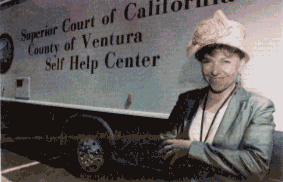|
|
|
Litigants
without lawyers flood courts
Pro
pers get help as their numbers grow |
 |
By SHARON LERMAN
Staff Writer |
 |
|
 Though
former U.S. Supreme Court Justice Harry Blackmun tweaked the language
of an axiom he used to color a 1975 dissenting opinion, the sentiment
was unmistakable. Though
former U.S. Supreme Court Justice Harry Blackmun tweaked the language
of an axiom he used to color a 1975 dissenting opinion, the sentiment
was unmistakable.
"If there's any truth to the old proverb that
'one who is his own lawyer has a fool for a client,' the Court . .
. now bestows a constitutional right on one to make a fool of
himself,'' Blackmun wrote in Faretta v. California, the 6-3
decision that codified the right to refuse counsel.
More than a quarter-century later, a task force
appointed by California Chief Justice Ronald George is challenging the
derision the courts have historically dumped on the people who proceed
in pro per.
The thrust of a 19-member Judicial Council Task
Force on Self-Represented Litigants, empanelled at the end of May, is
to spend the next 18 months creating a statewide plan to assist the
ever-expanding number of citizens who are unable - or simply
unwilling - to hire an attorney.
But members of the bench and bar say that
ensuring equal justice for the lawyerless also requires an
institutional change of identity: The court-house can no longer be
just a repository for documents and dispenser of rulings. And the
phrase being thrown around in connection with this shift is one
borrowed from the business world: customer service.
After Arthur Sims took over as executive officer
of Alameda County Superior Court, he removed signs at the clerks'
counters that noted they cannot give legal advice to citizens.
"If
we truly want unrepresented litigants to feel the court is open to
them, not just the affluent and attorneys, then we shouldn't start
out by |
See LITIGANTS |
|
| Insurance
carriers, defense counsel spar over conflicts |
 |
By NANCY McCARTHY
Staff Writer |
 |
|
Consider the following scenario: An attorney is
hired by an insurance company to defend one of its customers in a
personal injury case. At the same time, the attorney represents a
client in a totally unrelated matter who may wish to sue the same
insurance company.
As a result of a 1999 California appellate court
ruling, the attorney is precluded from filing suit in the second
matter.
Insurance defense attorneys complain they
routinely find themselves in this situation, which brings with it
potential for violating the Rules of Professional Conduct governing
the duty of loyalty and client confidentiality. "We face an ethical
dilemma on a daily basis," says Karl Keener, a Santa Monica attorney
who is past president of the Southern California Association of
Insurance Defense Counsel.
Keener
and other insurance defense lawyers want the State Bar to eliminate
so-called tripartite rep- |
See INSURERS |
|
| State
Bar will open nation's only drug court for lawyers |
 |
By NANCY McCARTHY
Staff Writer |
 |
|
In an unprecedented move, the State Bar will open
a drug court early next year as part of its increasing efforts to
rehabilitate alcoholic and drug-addicted attorneys. It will be the
only court of its kind at any professional regulatory agency in the
country.
Executives of the Office of the Chief Trial
Counsel and the State Bar Court are developing proposed guidelines to
govern who will be eligible for referral to the court, how lawyers
before the court will be monitored and how successful completion of
the program might affect possible discipline.
The new court will operate hand-in-hand with a
diversion and assistance program currently making its way through the
legislature.
That program, however, is primarily designed to
assist attorneys who voluntarily seek help and may or may not face
discipline. The drug court would handle attorneys suspected or accused
of misconduct.
"We
are not departing from our primary goal of public protection," said
Scott Drexel, the bar court's chief executive. "But if we can
rehabilitate some of these lawyers, we |
See DRUG
COURT |
|
| Nine vie for five bar board seats |
 |
|
Three unopposed candidates will begin three-year
terms on the State Bar Board of Governors in September, while six
others battle it out to represent two other seats on the 23-member
board.
Candidates from Districts Two (Alpine, Amador,
Calaveras, El Dorado, Napa, Sacramento, Solano, Sonoma, Tuolumne and
Yolo counties), Four (San Francisco and Marin counties) and Seven (Los
Angeles, office two) ran without opposition and were elected
automatically. |
See
ELECTION |
|

